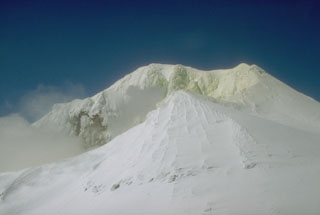Report on Martin (United States) — March 1995
Bulletin of the Global Volcanism Network, vol. 20, no. 3 (March 1995)
Managing Editor: Richard Wunderman.
Martin (United States) Large steam plumes, but no eruptive activity
Please cite this report as:
Global Volcanism Program, 1995. Report on Martin (United States) (Wunderman, R., ed.). Bulletin of the Global Volcanism Network, 20:3. Smithsonian Institution. https://doi.org/10.5479/si.GVP.BGVN199503-312140
Martin
United States
58.172°N, 155.361°W; summit elev. 1863 m
All times are local (unless otherwise noted)
On 15 March, the U.S. National Weather Service received a report from the town of King Salmon of steam plumes rising 600-900 m over the general vicinity of Mount Martin volcano in Katmai National Park. No eruptive activity was detected during analysis of satellite imagery. The mostly ice-covered Mount Martin stratovolcano has a poorly documented record of minor historical eruptive activity. However, vigorous steam plumes from its summit crater are common.
Geological Summary. The mostly ice-covered Mount Martin stratovolcano lies at the SW end of the Katmai volcano cluster in Katmai National Park. The volcano was named for George C. Martin, the first person to visit and describe the area after the 1912 eruption. It is capped by a 300-m-wide summit crater, which is ice-free because of an almost-constant steam plume; it also contains a shallow acidic lake. The edifice was constructed entirely during the Holocene, and overlies glaciated lava flows of the adjacent mid- to late-Pleistocene Alagoshak volcano to the WSW. Martin consists of a small fragmental cone that was the source of ten thick overlapping blocky dacitic lava flows, largely uneroded by glaciers, that descend 10 km to the NW, cover 31 km2, and form about 95% of the eruptive volume of the volcano. Two reports of historical eruptions that originated from uncertain sources were attributed by Muller et al. (1954) to Martin.
Information Contacts: Alaska Volcano Observatory.

